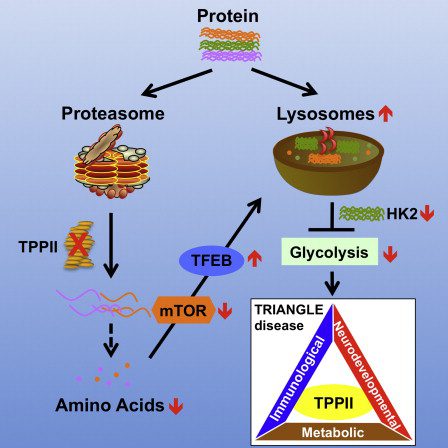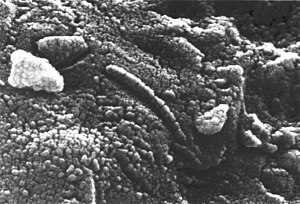Food for thought: Penrose v Ellis (1)
All experimental evidence of energy-dependent biologically-based cause and effect must be suppressed or ignored, and that’s what atheists prefer to do. See for instance: Hypothetical biogenic features in the context of the Alan Hills fossil. (Thanks to John Hewitt for reminding me of this.)
On August 6, 1996,[3] ALH84001 became newsworthy when it was claimed that the meteorite may contain evidence of traces of life from Mars, as published in an article in Science by David S. McKay of NASA.[14]
Under the scanning electron microscope structures were revealed that some scientists interpreted as fossils of bacteria-like lifeforms.
See for comparison: NASA, Jesus & Templeton?
Religion has nothing to do with science and the NASA Astrobiology Program has squandered precious public funds — 5% of its annual budget — for an investigation into how the world’s religions might respond to the discovery of life on other planets. It has handed over $1.108M to a religious think tank, a nonprofit corporation with wealth management professionals on its board that already has in excess of $23M in assets. It is money that could be spent productively on authentic journalism to more effectively expose the politics that drives world disasters, including the use of group mind control, religious and otherwise.
See also: Root microbiota drive direct integration of phosphate stress and immunity
My summary: They claim to provide new insight that links soil bacteria to plant growth in the context of the systems that simultaneously act to coordinate and maintain the assembly of the soil microbiome. The gut microbiome in humans, and the soil microbiome protect humans and plants from virus-driven energy theft. Simply put, the global microbiome protects all natural sources of food energy from genomic entropy.
Reported as: Researchers make discovery that could increase plant yield in wake of looming phosph
“We show precisely how a key ‘switch protein’,PHR1, controls the response to low levels of phosphate, a big stress for the plant, and also controls the plant immune system… “When the plant is stressed for this important nutrient, it turns down its immune system so it can focus on harvesting phosphate from the soil. Essentially, the plant sets its priorities on the cellular level.”
At the cellular level of plant life, the plant appears to automagically control light energy-dependent endogenous RNA interference in soil bacteria, which reproduce only in the context of nutrient-dependent pheromone-controlled quorum sensing.
See also: God or Dirt
Our multi-media presentations enlighten audiences with scientific evidence which refutes the theory of evolution. Topics include: No known naturalistic mechanism for origin of life; Laws of thermodynamics; Irreducible complexity; Law of Biogenesis and Complexity of cellular life.
Everything known to all serious scientists about energy-dependent changes on Earth links angstroms to ecosystems via the physiology of reproduction and supercoiled DNA, which protects all organized genomes from virus-driven energy theft. Everything known can be ignored if theorists start with evidence of life that came from outer space and became part of the record of fossil evidence that has been used to support theories of evolution.
See also: The Genetics of Success: How Single-Nucleotide Polymorphisms Associated With Educational Attainment Relate to Life-Course Development (Thanks to Jay R. Feireman for his continued efforts to sneak articles like this one in through the backdoor after he stopped me from commenting further on RNA-mediated cell type differentiation.)
Abstract conclusion:
Factors connecting DNA sequence with life outcomes may provide targets for interventions to promote population-wide positive development.
They focus on single nucleotide polymorphisms (SNPs) as a factor of interventions. In all living genera, the DNA sequence is energy-dependent and RNA-mediated protein folding chemistry links SNPs from endogenous RNA interference to the amino acid substitutions that differentiate all cell types via the pheromone-controlled physiology of reproduction. Examples of that fact are found in species from microbes to humans.
The structure of COMT Val158Met and its function are altered an SNP. A G-to-A base-pair substitution leads to a methionine (Met) valine (Val) substitution at codons 108/158 (COMT Val158Met). Natural selection for energy-dependent codon optimality links the Met allele to a fourfold decrease in enzymatic activity, which can be compared to the Val allele in carriers with increased prefrontal dopamine. That is how the A base pair substitution and the Met allele are associated with lower enzymatic activity (due to thermoinstability), and with exploratory behaviour.
See also: Many in Nation Tired of Explaining Things to Idiots
In a result that suggests a dismal future for the practice of explaining things to idiots, an overwhelming number of those polled said that they were considering abandoning such attempts altogether, with a broad majority agreeing with the statement, “This country is exhausting.”
Jay R. Feierman (6/14/14) [MODERATOR NOTE: I’m not going to post more from Kohl until he answers the very direct and simple question posed to him by anon, which is whether he (Kohl) believes that RNA splicing can change DNA.]
I gave up trying to explain any “beliefs” to human ethologists. But see my reply (6/5/16):
Now that Clarence Williams is back and jrf is again editing the responses he allows me to post, I hope everyone will see more than 800 examples of what they have missed.
The examples link energy-dependent epigenetically effected alternative RNA splicing from amino acid substitutions such as BDNF Val66Met and COMT Val158Met to cell type differentiation in all cell types of all living genera via what is known about biophysically constrained biologically-based cause and effect.
In the context of what is known about animal models, Samir et al (2016) published: MicroRNAs in the Host Response to Viral Infections of Veterinary Importance MicroRNAs in the Host Response to Viral Infections of Veterinary Importance
See also:
James V. Kohl: “Evolution by natural selection cannot be the outcome if something is not first selected. Selection is always for nutrients. It is as simple as that.”
7/25/13
Jay R. Feierman: Variation is not nutrient availability and the something that is doing the selecting is not the individual organism. A feature of an educated person is to realize what they do not know. Sadly, you don’t know that you have an incorrect understanding [of] Darwinian biological evolution.
7/26/13
Jay R. Feierman: I am absolutely certain that if you showed this statement to any professor of biology or genetics in any accredited university anywhere in the world that 100% of them would say that “Random mutations are the substrate upon which directional natural selection acts” is a correct and true statement.
When historians attempt to determine who was the most irresponsible advocate of neo-Darwinian pseudoscientific nonsense to ever cause the unnecessary suffering and premature death of millions, I hope Jay R. Feierman is given the greatest of all consideration. I can’t think of anyone who has continued to prevent scientific progress for 20 years by ignoring the facts we presented in this 1996 Hormones and Behavior review article.
From Fertilization to Adult Sexual Behavior
See this excerpt from our section on molecular epigenetics.
Yet another kind of epigenetic imprinting occurs in species as diverse as yeast, Drosophila, mice, and humans and is based upon small DNA-binding proteins called “chromo domain” proteins, e.g., polycomb. These proteins affect chromatin structure, often in telomeric regions, and thereby affect transcription and silencing of various genes (Saunders, Chue, Goebl, Craig, Clark, Powers, Eissenberg, Elgin, Rothfield, and Earnshaw, 1993; Singh, Miller, Pearce, Kothary, Burton, Paro, James, and Gaunt, 1991; Trofatter, Long, Murrell, Stotler, Gusella, and Buckler, 1995). Small intranuclear proteins also participate in generating alternative splicing techniques of pre-mRNA and, by this mechanism, contribute to sexual differentiation in at least two species, Drosophila melanogaster and Caenorhabditis elegans (Adler and Hajduk, 1994; de Bono, Zarkower, and Hodgkin, 1995; Ge, Zuo, and Manley, 1991; Green, 1991; Parkhurst and Meneely, 1994; Wilkins, 1995; Wolfner, 1988). That similar proteins perform functions in humans suggests the possibility that some human sex differences may arise from alternative splicings of otherwise identical genes.




[…] See Food for thought: Penrose v Ellis (1) […]